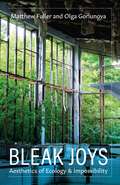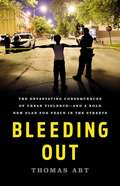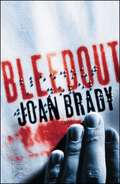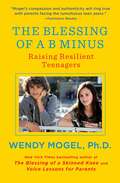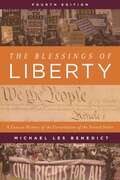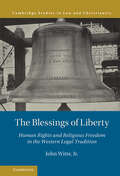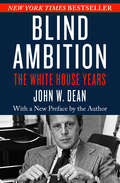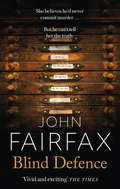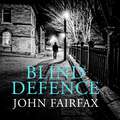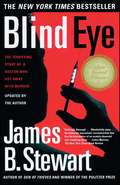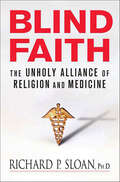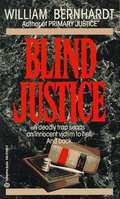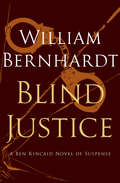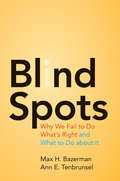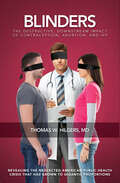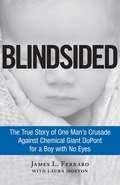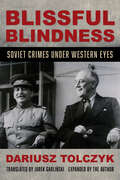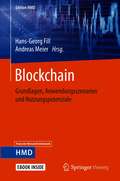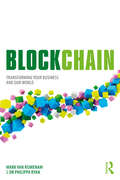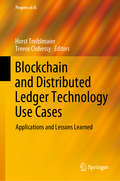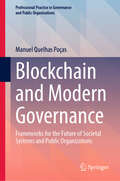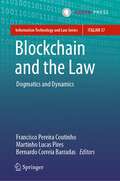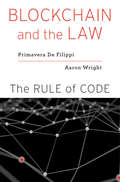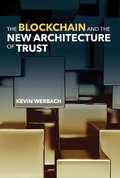- Table View
- List View
Bleak Joys: Aesthetics of Ecology and Impossibility (Posthumanities #53)
by Matthew Fuller Olga GoriunovaA philosophical and cultural distillation of the bleak joys in today&’s ambivalent ecologies and patterns of lifeBleak Joys develops an understanding of complex entities and processes—from plant roots to forests to ecological damage and its calculation—as aesthetic. It is also a book about &“bad&” things, such as anguish and devastation, which relate to the ecological and technical but are also constitutive of politics, the ethical, and the formation of subjects.Avidly interdisciplinary, Bleak Joys draws on scientific work in plant sciences, computing, and cybernetics, as well as mathematics, literature, and art in ways that are not merely illustrative of but foundational to our understanding of ecological aesthetics and the condition in which the posthumanities are being forged. It places the sensory world of plants next to the generalized and nonlinear infrastructure of irresolvability—the economics of indifference up against the question of how to make a home on Planet Earth in a condition of damaged ecologies. Crosscutting chapters on devastation, anguish, irresolvability, luck, plant, and home create a vivid and multifaceted approach that is as remarkable for its humor as for its scholarly complexity.Engaging with Deleuze, Guattari, and Bakhtin, among others, Bleak Joys captures the modes of crises that constitute our present ecological and political condition, and reckons with the means by which they are not simply aesthetically known but aesthetically manifest.
Bleeding Out: The Devastating Consequences of Urban Violence--and a Bold New Plan for Peace in the Streets
by Thomas AbtFrom a Harvard scholar and former Obama official, a powerful proposal for curtailing violent crime in America Urban violence is one of the most divisive and allegedly intractable issues of our time. But as Harvard scholar Thomas Abt shows in Bleeding Out, we actually possess all the tools necessary to stem violence in our cities.Coupling the latest social science with firsthand experience as a crime-fighter, Abt proposes a relentless focus on violence itself -- not drugs, gangs, or guns. Because violence is "sticky," clustering among small groups of people and places, it can be predicted and prevented using a series of smart-on-crime strategies that do not require new laws or big budgets. Bringing these strategies together, Abt offers a concrete, cost-effective plan to reduce homicides by over 50 percent in eight years, saving more than 12,000 lives nationally. Violence acts as a linchpin for urban poverty, so curbing such crime can unlock the untapped potential of our cities' most disadvantaged communities and help us to bridge the nation's larger economic and social divides.Urgent yet hopeful, Bleeding Out offers practical solutions to the national emergency of urban violence -- and challenges readers to demand action.
Bleedout
by Joan BradyHugh Freyl is a blind lawyer, scion of Illinois' most influential family. He recounts this story from the grave. David Marion is Freyl's protege and a young convicted killer whose release from prison Freyl has orchestrated. He now stands accused of Hugh Freyl's murder. None from Freyl's powerful inner circle will stand up for David's innocence. The perfect scapegoat for their misdoings, he alone bears the burden of proof. Revealing the inner-workings of an untouchable elite with all their tricks, entitlements and intricate financial schemes, Brady shows us a place that could be any small American city - a place where innocence can backfire and where fear is the only effective weapon against a corrupt government.
The Blessing of a B Minus: Using Jewish Teachings to Raise Resilient Teenagers (Playaway Adult Nonfiction Ser.)
by Wendy MogelNew York Times bestselling author, internationally known clinical psychologist, and lecturer Wendy Mogel returns with a revelatory new book on parenting teenagers. Mogel's sage advice on parenting young children has struck a chord with thousands of readers and made her one of today's most trusted parenting authorities. Now, in a long-awaited follow-up, Mogel addresses the question she hears most frequently: what to do when those children become teenagers, when their sense of independence and entitlement grows, the pressure to compete and succeed skyrockets, and communication becomes fraught with obstacles? With her warmth, wit, and signature combination of Jewish teachings and psychological research, Mogel helps parents to ably navigate the often rough journey through the teenage years and guide children to becoming confident, resilient young adults. By viewing the frustrating and worrisome elements of adolescence as "blessings," Mogel reveals that they are in fact necessary steps in psychological growth and character development to be met with faith, detachment, and a sense of humor rather than over-involvement and anxiety. Mogel gives parents the tools to do so and offers reassuring spiritual and ethical advice on * why influence is more effective than control. * teenage narcissism. * living graciously with rudeness. * the value of ordinary work. * why risk is essential preparation for the post-high school years. * when to step in and when to step back. * a sanctified approach to sex and substances. An important and inspiring book that will fortify parents through the teenage years, The Blessing of a B Minus is itself a blessing.
The Blessings of Liberty: A Concise History of the Constitution of the United States
by Michael Les BenedictThis concise, accessible text provides students with a history of American constitutional development in the context of political, economic, and social change. Constitutional historian Michael Benedict stresses the role that the American people have played over time in defining the powers of government and the rights of individuals and minorities. He covers important trends and events in U.S. constitutional history, encompassing key Supreme Court and lower-court cases. The volume begins by discussing the English and colonial origins of American constitutionalism. Following an analysis of the American Revolution's meaning to constitutional history, the text traces the Constitution's evolution from the Early Republic to the present day. This fourth edition is updated to include the 2016 election, the Trump administration, the 2020 election, and the first activities of the Biden administration.
The Blessings of Liberty: Human Rights and Religious Freedom in the Western Legal Tradition (Law and Christianity)
by John Witte, Jr.Leading legal scholar John Witte, Jr. explores the role religion played in the development of rights in the Western legal tradition and traces the complex interplay between human rights and religious freedom norms in modern domestic and international law. He examines how US courts are moving towards greater religious freedom, while recent decisions of the pan-European courts in Strasbourg and Luxembourg have harmed new religious minorities and threatened old religious traditions in Europe. Witte argues that the robust promotion and protection of religious freedom is the best way to protect many other fundamental rights today, even though religious freedom and other fundamental rights sometimes clash and need judicious balancing. He also responds to various modern critics who see human rights as a betrayal of Christianity and religious freedom as a betrayal of human rights.
Blind Ambition: The White House Years
by John W. DeanA six-month New York Times bestseller: &“Not only the best Watergate book, but a very good book indeed&” (The Sunday Times). As White House counsel to Richard Nixon, a young John W. Dean was one of the primary players in the Watergate scandal—and ultimately became the government&’s key witness in the investigations that ended the Nixon presidency. After the scandal subsided, Dean rebuilt his career, first in business and then as a bestselling author and lecturer. But while the events were still fresh in his mind, he wrote this remarkable memoir about the operations of the Nixon White House and the crisis that led to the president&’s resignation. Called &“fascinating&” by Commentary, which noted that &“there can be little doubt of [Dean's] memory or his candor,&” Blind Ambition offers an insider&’s view of the deceptions and machinations that brought down an administration and changed the American people&’s view of politics and power. It also contains Dean&’s own unsparing reflections on the personal demons that drove him to participate in the sordid affair. Upon its original publication, Kirkus Reviews hailed it &“the flip side of All the President&’s Men—a document, a minefield, and prime entertainment.&” Today, Dean is a respected and outspoken advocate for transparency and ethics in government, and the bestselling author of such books as The Nixon Defense, Worse Than Watergate, and Conservatives Without Conscience. Here, in Blind Ambition, he &“paints a candid picture of the sickening moral bankruptcy which permeated the White House and to which he contributed. His memory of who said what and to whom is astounding&” (Foreign Affairs).
Blind Defence (Benson and De Vere)
by John Fairfax'Vivid and exciting' The TimesWINNER OF THE PRIX DU MASQUEShe was found hanging in a dingy London bedsit with a blood orange in her mouth. Diane Heybridge, a young woman without a past or much of a future, has captured in death the compassion denied her in life. For the prosecution, this seeming suicide is nothing more than a bungled killing and a disgusted public looks to Court 2 of the Old Bailey for justice. Her callous, jilted partner Brent Stainsby stands accused of her murder and he's turned to the maverick legal team William Benson and Tess de Vere to defend him. However, as the trial unfolds it soon becomes clear that there is far more to Diane Heybridge than meets the eye. She wasn't the weak and downtrodden victim now being presented to the jury. She was capable of a sophisticated form of vengeance. By the same token, Brent Stainsby isn't who he seems to be either. He's hiding a motive for murder unknown to the police and may well be playing a deadly game of poker with the judicial process. What began as a simple trial rapidly turns into a complex search for the truth beyond the confines of the courtroom...
Blind Defence (Benson and De Vere)
by John Fairfax'An all-action court drama' Sunday Times on Summary JusticeShe was found hanging in a dingy London bedsit with a blood orange in her mouth. Diane Heybridge, a young woman without a past or much of a future, has captured in death the compassion denied her in life. For the prosecution, this seeming suicide is nothing more than a bungled killing and a disgusted public looks to Court 2 of the Old Bailey for justice. Her callous, jilted partner Brent Stainsby stands accused of her murder and he's turned to the maverick legal team William Benson and Tess de Vere to defend him. However, as the trial unfolds it soon becomes clear that there is far more to Diane Heybridge than meets the eye. She wasn't the weak and downtrodden victim now being presented to the jury. She was capable of a sophisticated form of vengeance. By the same token, Brent Stainsby isn't who he seems to be either. He's hiding a motive for murder unknown to the police and may well be playing a deadly game of poker with the judicial process. What began as a simple trial rapidly turns into a complex search for the truth beyond the confines of the courtroom...
Blind Defence (Benson and De Vere)
by John Fairfax'Vivid and exciting' The TimesWINNER OF THE PRIX DU MASQUEShe was found hanging in a dingy London bedsit with a blood orange in her mouth. Diane Heybridge, a young woman without a past or much of a future, has captured in death the compassion denied her in life. For the prosecution, this seeming suicide is nothing more than a bungled killing and a disgusted public looks to Court 2 of the Old Bailey for justice. Her callous, jilted partner Brent Stainsby stands accused of her murder and he's turned to the maverick legal team William Benson and Tess de Vere to defend him. However, as the trial unfolds it soon becomes clear that there is far more to Diane Heybridge than meets the eye. She wasn't the weak and downtrodden victim now being presented to the jury. She was capable of a sophisticated form of vengeance. By the same token, Brent Stainsby isn't who he seems to be either. He's hiding a motive for murder unknown to the police and may well be playing a deadly game of poker with the judicial process. What began as a simple trial rapidly turns into a complex search for the truth beyond the confines of the courtroom...
Blind Eye: The Terrifying Story Of A Doctor Who Got Away With (G. K. Hall Nonfiction Ser.)
by James B. StewartA medical thriller from Pulitzer Prize-winning author James B. Stewart about serial killer doctor Michael Swango and the medical community that chose to turn a blind eye on his criminal activities.No one could believe that the handsome young doctor might be a serial killer. Wherever he was hired--in Ohio, Illinois, New York, South Dakota--Michael Swango at first seemed the model physician. Then his patients began dying under suspicious circumstances. At once a gripping read and a hard-hitting look at the inner workings of the American medical system, Blind Eye describes a professional hierarchy where doctors repeatedly accept the word of fellow physicians over that of nurses, hospital employees, and patients--even as horrible truths begin to emerge. With the prodigious investigative reporting that has defined his Pulitzer Prize-winning career, James B. Stewart has tracked down survivors, relatives of victims, and shaken coworkers to unearth the evidence that may finally lead to Swango's conviction.Combining meticulous research with spellbinding prose, Stewart has written a shocking chronicle of a psychopathic doctor and of the medical establishment that chose to turn a blind eye on his criminal activities.
Blind Faith: The Unholy Alliance of Religion and Medicine
by Richard P. SloanPharmacists who refuse to fill prescriptions for contraceptives. Surgeons who pray in the OR. Pro-life clinics and end-of-life interventions, intelligent-design activists and stem-cell-research opponents. Is this the state of modern medicine in America?In Blind Faith, Dr. Richard P. Sloan examines the fragile balance and dangerous alliance between religion and medicine—two practices that have grown disconcertingly close during the twenty-first century. While Sloan does not dispute the fact that religion can bring a sense of comfort in times of difficulty, he nevertheless believes, and in fact proves, that there is no compelling evidence that faith provides an actual cure for any ailment. By exposing the flawed research, Sloan gives readers the tools to understand when good medical science is subverted and, at the same time, provides a thought-provoking examination into the origins and varieties of faith, and human nature itself.
Blind Justice (Ben Kincaid Series #2)
by William BernhardtLawyer Ben Kincaid leaves the cozy corporate law world to defend criminal defendants. Then, his close friend is accused of murder. Ben fights a system bent on conviction, not justice, and a judge who despises Ben.
Blind Justice (The Ben Kincaid Novels #2)
by William BernhardtFrom &“a first-rate storyteller&”: An ex-corporate lawyer in Oklahoma starts a new career defending the innocent (Tulsa World). Ben Kincaid is too honest for corporate law. When his refusal to compromise his ideals gets him tossed out of Tulsa&’s largest, most corrupt firm, he hangs out his shingle on the rough side of town. He works for peanuts—and occasionally chickens—but is safe in the knowledge that he is helping people who have nowhere else to turn. His newest client is also one of his oldest friends: Christina McCall, a onetime colleague in the world of corporate law. Christina is beautiful, daringly dressed, and on trial for a murder she didn&’t commit. The last thing Christina remembers is the smell of her mother&’s perfume. When she comes out of her stupor, her client is dead, the gun is in her hand, and the police are cuffing her wrists. Proving her innocence may be an impossible, but the impossible is becoming Kincaid&’s specialty.
Blind Spots: Why We Fail to Do What's Right and What to Do about It
by Max H. Bazerman Ann E. TenbrunselWhen confronted with an ethical dilemma, most of us like to think we would stand up for our principles. But we are not as ethical as we think we are. In Blind Spots, leading business ethicists Max Bazerman and Ann Tenbrunsel examine the ways we overestimate our ability to do what is right and how we act unethically without meaning to. From the collapse of Enron and corruption in the tobacco industry, to sales of the defective Ford Pinto, the downfall of Bernard Madoff, and the Challenger space shuttle disaster, the authors investigate the nature of ethical failures in the business world and beyond, and illustrate how we can become more ethical, bridging the gap between who we are and who we want to be. Explaining why traditional approaches to ethics don't work, the book considers how blind spots like ethical fading--the removal of ethics from the decision--making process--have led to tragedies and scandals such as the Challenger space shuttle disaster, steroid use in Major League Baseball, the crash in the financial markets, and the energy crisis. The authors demonstrate how ethical standards shift, how we neglect to notice and act on the unethical behavior of others, and how compliance initiatives can actually promote unethical behavior. They argue that scandals will continue to emerge unless such approaches take into account the psychology of individuals faced with ethical dilemmas. Distinguishing our "should self" (the person who knows what is correct) from our "want self" (the person who ends up making decisions), the authors point out ethical sinkholes that create questionable actions. Suggesting innovative individual and group tactics for improving human judgment, Blind Spots shows us how to secure a place for ethics in our workplaces, institutions, and daily lives.
Blinders: The Destructive, Downstream Impact of Contraception, Abortion, and IVF
by Thomas W. HilgersOver the last 50 or 60 years, there has appeared a directional shift in the medical and social culture of the United States. We see it in the news programs every night, sometimes several times a night. Often there are generic reasons given for these changes such as “poverty and hopelessness.” But could there be other reasons? Could the medical profession be playing an important role in the violence and destructiveness of this cultural shift? Has there been any critical self-examination by the medical profession which usually demands evidence-based conclusions to be assessed? Or are there some questions that are too difficult for individuals to investigate, not because it’s impossible to investigate them, but because it can be painful and because the attitudes of a collective group of colleagues may be preventing these questions from being asked. It is as if we have BLINDERS on!This book makes an attempt to address some new questions that have rarely been asked but should be. This book, with a full-color interior, takes an objective look at data that has been produced by mostly government-based statistical gathering systems, some published in peer-reviewed medical journals and even some in news reports.
Blindsided: The True Story of One Man's Crusade Against Chemical Giant DuPont for a Boy with No Eyes
by James L. FerraroIn 1996, an unprecedented decade-long courtroom battle was waged in Florida to help bring justice and hope to the family of a young boy born with no eyes after his mother was doused outside of a local u-pick farm by a chemical fungicide believed to have caused his birth defect and the birth defects of many other children. It was a battle that nearly everyone but attorney Jim Ferraro deemed unwinnable. After all, it involved one of the world's most powerful industrial giants. In the process, it was a fight that changed the landscape of tort law forever. Before it was over Castillo-vs-DuPont would go down in history as the first and one of the most important cases of its kind, setting precedent and also sparking a crucial debate over the questionable use of what is known as the "junk-science defense." Blindsided is a real life David and Goliath story-a true courtroom drama for the ages.
Blissful Blindness: Soviet Crimes under Western Eyes
by Dariusz TołczykThe most heinous Soviet crimes – the Red Terror, brutal collectivization, the Great Famine, the Gulag, Stalin's Great Terror, mass deportations, and other atrocities – were treated in the West as a controversial topic. With the Cold War dichotomy of Western democracy versus Soviet communism deeply imprinted in our minds, we are not always aware that these crimes were very often questioned, dismissed, denied, sometimes rationalized, and even outright glorified in the Western world. Facing a choice of whom to believe –the survivors or Soviet propaganda– many Western opinion leaders chose in favor of Soviet propaganda. Even those who did not believe it behaved sometimes as if they did. Blissful Blindness explores Western reactions (and lack thereof) to Soviet crimes from the Bolshevik revolution to the collapse of Soviet communism in order to understand ideological, political, economic, cultural, personal, and other motivations behind this puzzling phenomenon of willful ignorance. But the significance of Dariusz Tolczyk's book reaches beyond its direct historical focus. Written for audiences not limited to scholars and specialists, this book not only opens one's eyes to rarely examined aspects of the twentieth century but also helps one see how astonishingly relevant this topic is in our contemporary world.
Blockchain: Grundlagen, Anwendungsszenarien und Nutzungspotenziale (Edition HMD)
by Andreas Meier Hans-Georg FillSowohl in der Praxis als auch der wissenschaftlichen Forschung ist das Thema "Blockchain" aktuell von großem Interesse. Noch scheint sich die Technologie am Anfang ihrer Entwicklung zu befinden: Plattformen wie Bitcoin, Ethereum, Hyperledger Fabric, Libra, TradeLens oder andere weisen bereits einen beeindruckenden Reifegrad in ihrer technischen Entwicklung auf. Dennoch befinden sich erst wenige von ihnen bzw. darauf aufbauende Applikationen im produktiven Einsatz bei Unternehmen. Hier können nicht nur Forschende optimal dazu beitragen, neue Ideen zu entwickeln, noch nicht betrachtete Anwendungsfälle und -domänen zu untersuchen und erste Prototypen für den konkreten Einsatz zu entwickeln. Die Beiträge der vorliegenden Edition HMD bieten dazu einen umfassenden Überblick und zeigen die große Bandbreite an möglichen Anwendungsfeldern für Blockchains. Das Herausgeberwerk vermittelt somit die Grundlagen zur Blockchain-Technologie, widmet sich den Smart Contracts und beschreibt wichtige Anwendungsszenarien, erste Fallbeispiele und rechtliche Aspekte. Wie typisch für die Fachbuchreihe Edition HMD greifen die Beitragsautoren das Thema aus Sicht von Forschung und Praxis gleichermaßen auf. Ein Glossar mit den wichtigsten Begriffen rundet das Buch ab.
Blockchain: Transforming Your Business and Our World
by Mark Van Rijmenam Philippa RyanThe internet was envisaged as a decentralised global network, but in the past 25 years it has come to be controlled by a few, very powerful, centralised companies. Blockchain is a technological paradigm shift that allows secure, reliable, and direct information transfer between individuals, organisations, and things, so that we can manage, verify, and control the use of our own data. Blockchain also offers a new opportunity for humanity to fix some major problems. It can authenticate data, manage its analysis, and automate its use. With better data comes better decision-making. In this way, Blockchain can contribute to solving climate change, reduce voting fraud, fix our identity systems, improve fair trade, and give the poor an opportunity to improve their lives by monetising their (digital) capital. A world built upon peer-to-peer transactions and smart contracts can empower individuals and communities. This book offers a fresh perspective with which to consider this transformative technology. It describes how Blockchain can optimise the processes that run our society. It provides practical solutions to global problems and offers a roadmap to incorporate Blockchain in your business. It offers a blueprint for a better world. Filled with easy-to-understand examples, this book shows how Blockchain can take over where the internet has fallen short.
Blockchain and Distributed Ledger Technology Use Cases: Applications and Lessons Learned (Progress in IS)
by Horst Treiblmaier Trevor ClohessyBlockchain and other trustless systems have gone from being relatively obscure technologies, which were only known to a small community of computer scientists and cryptologists, to mainstream phenomena that are now considered powerful game changers for many industries. This book explores and assesses real-world use cases and case studies on blockchain and related technologies. The studies describe the respective applications and address how these technologies have been deployed, the rationale behind their application, and finally, their outcomes. The book shares a wealth of experiences and lessons learned regarding financial markets, energy, SCM, healthcare, law and compliance. Given its scope, it is chiefly intended for academics and practitioners who want to learn more about blockchain applications.
Blockchain and Modern Governance: Frameworks for the Future of Societal Systems and Public Organizations (Professional Practice in Governance and Public Organizations)
by Manuel Quelhas PoçasThis book shows how blockchain technology can transform the foundational systems of our society. Written by an industry expert with a background in political science, international relations, law, management, and technology, the book merges social, political, economic, and legal theories with technological expertise to present a groundbreaking framework for using blockchain in governance and public organizations. Imagine a country as a digital space where humans and resources interact seamlessly. This book explores such possibilities, illustrating how blockchain can redefine governance beyond physical borders. Addressing the urgent need for adaptive solutions in a globally interconnected world, the author provides a strategic roadmap for implementing blockchain in public governance. With clear explanations, real-world examples, and practical applications, this book will inspire and guide professionals and policy-makers seeking to utilize blockchain technology for innovative governance solutions.
Blockchain and the Law: Dogmatics and Dynamics (Information Technology and Law Series #37)
by Francisco Pereira Coutinho Martinho Lucas Pires Bernardo Correia BarradasThis book discusses the dogmatic (that what is settled) and the dynamic (that what is changing) aspects of the relationship between blockchain and the law from a critical perspective. With contributions from legal and financial experts involved in both academy and business from Europe, Africa and North and South America, the book looks at the abstract complexities and practical challenges of regulating blockchain technology and its developments, such as crypto assets and smart contracts, from the perspectives of financial, tax, civil, and international law. Moreover, the book also delves into some exciting and cutting-edge related topics such as blockchain applications for litigation, CBDC and elections.The volume offers insightful considerations that will be helpful for legal practitioners involved in the crypto and Distributed Ledger Technology (DLT) phenomenon.Francisco Pereira Coutinho is Associate Professor at the Nova School of Law in Lisbon, Portugal.Martinho Lucas Pires is Teaching Assistant in the Department of Law of the Universidade Católica Portuguesa in Lisbon, Portugal.Bernardo Correia Barradas is a Lawyer and Senior Legal Advisor in payments in Washington DC, United States.
Blockchain and the Law: The Rule of Code
by Primavera De De FilippiSince Bitcoin appeared in 2009, the digital currency has been hailed as an Internet marvel and decried as the preferred transaction vehicle for all manner of criminals. It has left nearly everyone without a computer science degree confused: Just how do you “mine” money from ones and zeros? The answer lies in a technology called blockchain, which can be used for much more than Bitcoin. A general-purpose tool for creating secure, decentralized, peer-to-peer applications, blockchain technology has been compared to the Internet itself in both form and impact. Some have said this tool may change society as we know it. Blockchains are being used to create autonomous computer programs known as “smart contracts,” to expedite payments, to create financial instruments, to organize the exchange of data and information, and to facilitate interactions between humans and machines. The technology could affect governance itself, by supporting new organizational structures that promote more democratic and participatory decision making. Primavera De Filippi and Aaron Wright acknowledge this potential and urge the law to catch up. That is because disintermediation—a blockchain’s greatest asset—subverts critical regulation. By cutting out middlemen, such as large online operators and multinational corporations, blockchains run the risk of undermining the capacity of governmental authorities to supervise activities in banking, commerce, law, and other vital areas. De Filippi and Wright welcome the new possibilities inherent in blockchains. But as Blockchain and the Law makes clear, the technology cannot be harnessed productively without new rules and new approaches to legal thinking.
The Blockchain and the New Architecture of Trust (Information Policy)
by Kevin WerbachHow the blockchain—a system built on foundations of mutual mistrust—can become trustworthy.The blockchain entered the world on January 3, 2009, introducing an innovative new trust architecture: an environment in which users trust a system—for example, a shared ledger of information—without necessarily trusting any of its components. The cryptocurrency Bitcoin is the most famous implementation of the blockchain, but hundreds of other companies have been founded and billions of dollars invested in similar applications since Bitcoin's launch. Some see the blockchain as offering more opportunities for criminal behavior than benefits to society. In this book, Kevin Werbach shows how a technology resting on foundations of mutual mistrust can become trustworthy. The blockchain, built on open software and decentralized foundations that allow anyone to participate, seems like a threat to any form of regulation. In fact, Werbach argues, law and the blockchain need each other. Blockchain systems that ignore law and governance are likely to fail, or to become outlaw technologies irrelevant to the mainstream economy. That, Werbach cautions, would be a tragic waste of potential. If, however, we recognize the blockchain as a kind of legal technology that shapes behavior in new ways, it can be harnessed to create tremendous business and social value.
